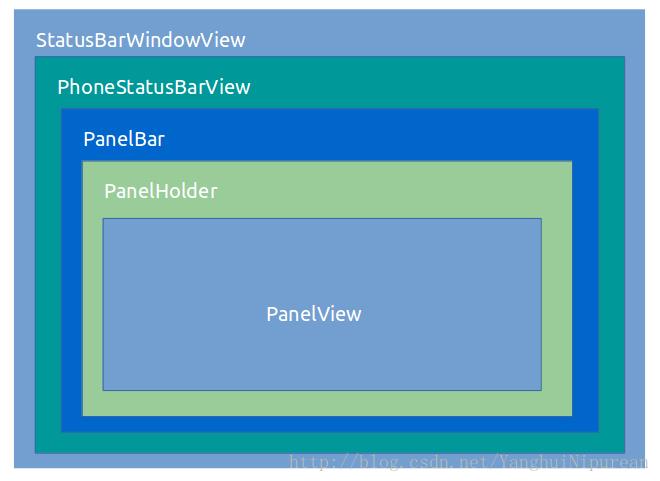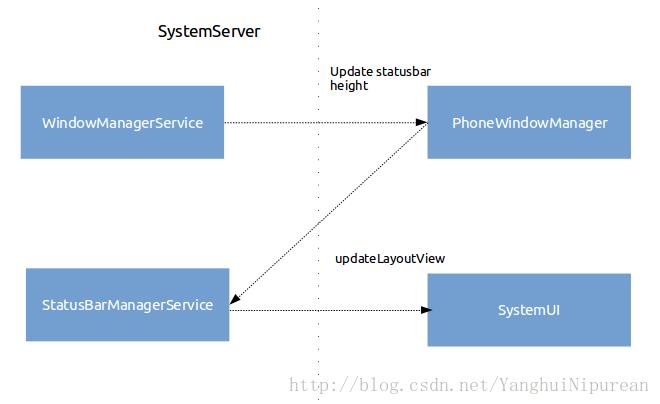SystemUI 剖析
Posted Nipuream
tags:
篇首语:本文由小常识网(cha138.com)小编为大家整理,主要介绍了SystemUI 剖析相关的知识,希望对你有一定的参考价值。
序言
17年上半年主要做车机项目SystemUI的工作,一般的来说可以选择在源码的基础上定制,也可以重新编写。具体选择哪种方案,也要根据自身项目的需求和工作量来考虑,但是不管选择哪种,都需要对SystemUI源码有一定的了解。本文主要先从大体上了解整个SystemUI的运行机制,然后再从状态栏的图标如何显示,下拉菜单是如何的实现,来剖析这个模块的运行原理,最后用一个需求来深入的了解SystemUI模块。希望能够帮助有这方面需求的同学,当然了,本文都是笔者自己对代码的理解,如果有不正确的地方,欢迎留言指出!
整体架构
相信很多没有了解过SystemUI的同学都觉得它很神秘,因为这个Application很特殊,它和系统的联系很紧密,而且需要在源码的环境下编译,所以这也是和应用开发者关系比较疏远的原因之一。下图是SystemUI的整体架构图,我看过android 4.4和6.0的代码,虽然代码变化很大,但是原理和核心代码都是差不多的。

SystemUI的启动是由SystemServer进程来操作的,在整个系统资源,服务加载完成差不多的时候,调用了startSystemUI() 来启动一个服务SystemUIService ,此时就进入了SystemUI的应用程序世界了。
static final void startSystemUi(Context context)
Intent intent = new Intent();
intent.setComponent(new ComponentName("com.android.systemui",
"com.android.systemui.SystemUIService"));
//Slog.d(TAG, "Starting service: " + intent);
context.startServiceAsUser(intent, UserHandle.OWNER);
首先来说下一个aidl文件,叫做IStatusBar.aidl,它的路径在frameworks/base/core/java/com/android/internal/statusbar 下。它是framework和SystemUI的通信接口,包括我们的StatusBarManagerService封装的也是这个接口。我们的SystemUI主要是显示系统状态的改变,一般的由内部和外部导致,比如系统电量的改变,SystemUI会接收系统广播来修改,这种一般不会暴露给外部使用,不然就导致显示异常,还有种是外部导致SystemUI显示的变化,像其他应用发来通知,隐藏状态栏等,这个就需要我们的IStatusBar.aidl来承担之间的通信规则了。当我们的SystemSever进程来启动我们的SystemUIService,我们SystemUIService会启动很多的类,而这些类都是继承SystemUI接口的,并且都是有自己的职责所在。
/**
* Makes sure that all the SystemUI services are running. If they are already running, this is a
* no-op. This is needed to conditinally start all the services, as we only need to have it in
* the main process.
*
* <p>This method must only be called from the main thread.</p>
*/
public void startServicesIfNeeded()
if (mServicesStarted)
return;
if (!mBootCompleted)
// check to see if maybe it was already completed long before we began
// see ActivityManagerService.finishBooting()
if ("1".equals(SystemProperties.get("sys.boot_completed")))
mBootCompleted = true;
if (DEBUG) Log.v(TAG, "BOOT_COMPLETED was already sent");
Log.v(TAG, "Starting SystemUI services.");
final int N = SERVICES.length;
for (int i=0; i<N; i++)
Class<?> cl = SERVICES[i];
if (DEBUG) Log.d(TAG, "loading: " + cl);
try
mServices[i] = (SystemUI)cl.newInstance();
catch (IllegalAccessException ex)
throw new RuntimeException(ex);
catch (InstantiationException ex)
throw new RuntimeException(ex);
mServices[i].mContext = this;
mServices[i].mComponents = mComponents;
if (DEBUG) Log.d(TAG, "running: " + mServices[i]);
mServices[i].start();
if (mBootCompleted)
mServices[i].onBootCompleted();
mServicesStarted = true;
下面是启动的所有接口,
/**
* The classes of the stuff to start.
*/
private final Class<?>[] SERVICES = new Class[]
com.android.systemui.tuner.TunerService.class,
com.android.systemui.keyguard.KeyguardViewMediator.class,
com.android.systemui.recents.Recents.class,
com.android.systemui.volume.VolumeUI.class,
com.android.systemui.statusbar.SystemBars.class,
com.android.systemui.usb.StorageNotification.class,
com.android.systemui.power.PowerUI.class,
com.android.systemui.media.RingtonePlayer.class,
com.android.systemui.keyboard.KeyboardUI.class,
;
我们这里只研究下主要试图的部分,也就是我们的SystemBars,这个类主要的工作就是通过类加载器生成我们的PhoneStatusBar,然后调用它的start()方法,我们切换到PhoneStatusBar这个类来,PhoneStatusBar这个类承担了最主要的添加,移除,更新视图的重任,它负责解析状态栏,导航栏的布局文件,然后通过WindowManagerService来生成Window对象,它实现了IStatusBar的所有接口,负责接收外界所有的关于SystemUI视图更新的消息。
视图
视图这块主要有三个模块分别是状态栏,导航栏,还有下拉模块。状态栏主要显示系统的状态,导航栏一般提供了快捷Home,最近打开的应用,和回到上一层,下拉菜单提供了一些快捷操作,通知的显示,这里就不讲导航栏了,感兴趣可以自行了解。来看看状态栏吧,小小的一个区域,Google却把它封装成一层又一层的,整个statusbar布局可以说是非常复杂,不花点精力真的不知道哪对哪。

statusbar的整体结构可以简化如上图所示,statusbar的图标显示在PhoneStatusBarView 那一层,其中又包裹着moreIcons和notificationIcons,下面是6.0的布局文件。
<com.android.systemui.statusbar.phone.PhoneStatusBarView
xmlns:android="http://schemas.android.com/apk/res/android"
xmlns:systemui="http://schemas.android.com/apk/res/com.android.systemui"
android:id="@+id/status_bar"
android:background="@drawable/system_bar_background"
android:orientation="vertical"
android:focusable="false"
android:descendantFocusability="afterDescendants"
>
<ImageView
android:id="@+id/notification_lights_out"
android:layout_width="@dimen/status_bar_icon_size"
android:layout_height="match_parent"
android:paddingStart="6dip"
android:paddingBottom="2dip"
android:src="@drawable/ic_sysbar_lights_out_dot_small"
android:scaleType="center"
android:visibility="gone"
/>
<LinearLayout android:id="@+id/status_bar_contents"
android:layout_width="match_parent"
android:layout_height="match_parent"
android:paddingStart="6dp"
android:paddingEnd="8dp"
android:orientation="horizontal"
>
<com.android.systemui.statusbar.AlphaOptimizedFrameLayout
android:id="@+id/notification_icon_area"
android:layout_width="0dip"
android:layout_height="match_parent"
android:layout_weight="1"
android:orientation="horizontal"
>
<!-- The alpha of this area is both controlled from PhoneStatusBarTransitions and
PhoneStatusBar (DISABLE_NOTIFICATION_ICONS), so we need two views here. -->
<com.android.keyguard.AlphaOptimizedLinearLayout
android:id="@+id/notification_icon_area_inner"
android:layout_width="match_parent"
android:layout_height="match_parent"
>
<com.android.systemui.statusbar.StatusBarIconView android:id="@+id/moreIcon"
android:layout_width="@dimen/status_bar_icon_size"
android:layout_height="match_parent"
android:src="@drawable/stat_notify_more"
android:visibility="gone"
/>
<com.android.systemui.statusbar.phone.IconMerger android:id="@+id/notificationIcons"
android:layout_width="match_parent"
android:layout_height="match_parent"
android:layout_alignParentStart="true"
android:gravity="center_vertical"
android:orientation="horizontal"/>
</com.android.keyguard.AlphaOptimizedLinearLayout>
</com.android.systemui.statusbar.AlphaOptimizedFrameLayout>
<com.android.keyguard.AlphaOptimizedLinearLayout android:id="@+id/system_icon_area"
android:layout_width="wrap_content"
android:layout_height="match_parent"
android:orientation="horizontal"
>
<include layout="@layout/system_icons" />
<com.android.systemui.statusbar.policy.Clock
android:id="@+id/clock"
android:textAppearance="@style/TextAppearance.StatusBar.Clock"
android:layout_width="wrap_content"
android:layout_height="match_parent"
android:singleLine="true"
android:paddingStart="7dp"
android:gravity="center_vertical|start"
/>
</com.android.keyguard.AlphaOptimizedLinearLayout>
</LinearLayout>
</com.android.systemui.statusbar.phone.PhoneStatusBarView>我们一般动态显示的图标在标签下system_icons布局中,
<LinearLayout xmlns:android="http://schemas.android.com/apk/res/android"
android:id="@+id/system_icons"
android:layout_width="wrap_content"
android:layout_height="match_parent"
android:gravity="center_vertical">
<com.android.keyguard.AlphaOptimizedLinearLayout android:id="@+id/statusIcons"
android:layout_width="wrap_content"
android:layout_height="match_parent"
android:gravity="center_vertical"
android:orientation="horizontal"/>
<include layout="@layout/signal_cluster_view"
android:id="@+id/signal_cluster"
android:layout_width="wrap_content"
android:layout_height="wrap_content"
android:layout_marginStart="2.5dp"/>
<!-- battery must be padded below to match assets -->
<com.android.systemui.BatteryMeterView android:id="@+id/battery"
android:layout_height="14.5dp"
android:layout_width="9.5dp"
android:layout_marginBottom="@dimen/battery_margin_bottom"/>
</LinearLayout>可以看到电池电量和信号是专门的控件去处理的,因为这块是一直显示在我们的状态栏上的,并且由系统去修改的,上面也提到了,这个是不提供外界修改的接口。其他的图标的更新是在id叫statusIcons的一个线性布局中,代码控制模块是通过CommandQueue将回调传递给PhoneStatusBar,然后PhoneStatusBar又交给StatusBarIconController中,以下是部分代码
public void addSystemIcon(String slot, int index, int viewIndex, StatusBarIcon icon)
boolean blocked = mIconBlacklist.contains(slot);
StatusBarIconView view = new StatusBarIconView(mContext, slot, null, blocked);
view.set(icon);
mStatusIcons.addView(view, viewIndex, new LinearLayout.LayoutParams(
ViewGroup.LayoutParams.WRAP_CONTENT, mIconSize));
view = new StatusBarIconView(mContext, slot, null, blocked);
view.set(icon);
mStatusIconsKeyguard.addView(view, viewIndex, new LinearLayout.LayoutParams(
ViewGroup.LayoutParams.WRAP_CONTENT, mIconSize));
applyIconTint();
public void updateSystemIcon(String slot, int index, int viewIndex,
StatusBarIcon old, StatusBarIcon icon)
StatusBarIconView view = (StatusBarIconView) mStatusIcons.getChildAt(viewIndex);
view.set(icon);
view = (StatusBarIconView) mStatusIconsKeyguard.getChildAt(viewIndex);
view.set(icon);
applyIconTint();
public void removeSystemIcon(String slot, int index, int viewIndex)
mStatusIcons.removeViewAt(viewIndex);
mStatusIconsKeyguard.removeViewAt(viewIndex);
mStatusIcons对应的就是前面介绍的id为statusIcons的布局。我们再来分析下下拉菜单的原理机制,当我们触摸手机的状态栏的位置,下拉菜单会随着我们手势做相应的处理。还记得我们状态栏最外层布局节点是PhoneStatusBarView,
@Override
public boolean onTouchEvent(MotionEvent event)
boolean barConsumedEvent = mBar.interceptTouchEvent(event);
if (DEBUG_GESTURES)
if (event.getActionMasked() != MotionEvent.ACTION_MOVE)
EventLog.writeEvent(EventLogTags.SYSUI_PANELBAR_TOUCH,
event.getActionMasked(), (int) event.getX(), (int) event.getY(),
barConsumedEvent ? 1 : 0);
return barConsumedEvent || super.onTouchEvent(event);
首先先看看mBar是否要拦截这个事件,如果没有拦截则调用父类的onTouchEvent()方法,这里的mBar其实就是PhoneStatusBar这个类,这个类相当于一个控制器的作用,再看看PhoneStatusBar什么时候会拦截这个事件,
public boolean interceptTouchEvent(MotionEvent event)
if (DEBUG_GESTURES)
if (event.getActionMasked() != MotionEvent.ACTION_MOVE)
EventLog.writeEvent(EventLogTags.SYSUI_STATUSBAR_TOUCH,
event.getActionMasked(), (int) event.getX(), (int) event.getY(),
mDisabled1, mDisabled2);
if (SPEW)
Log.d(TAG, "Touch: rawY=" + event.getRawY() + " event=" + event + " mDisabled1="
+ mDisabled1 + " mDisabled2=" + mDisabled2 + " mTracking=" + mTracking);
else if (CHATTY)
if (event.getAction() != MotionEvent.ACTION_MOVE)
Log.d(TAG, String.format(
"panel: %s at (%f, %f) mDisabled1=0x%08x mDisabled2=0x%08x",
MotionEvent.actionToString(event.getAction()),
event.getRawX(), event.getRawY(), mDisabled1, mDisabled2));
if (DEBUG_GESTURES)
mGestureRec.add(event);
if (mStatusBarWindowState == WINDOW_STATE_SHOWING)
final boolean upOrCancel =
event.getAction() == MotionEvent.ACTION_UP ||
event.getAction() == MotionEvent.ACTION_CANCEL;
if (upOrCancel && !mExpandedVisible)
setInteracting(StatusBarManager.WINDOW_STATUS_BAR, false);
else
setInteracting(StatusBarManager.WINDOW_STATUS_BAR, true);
return false;
从这里可以看出,最后return的是false,而其中执行的一个比较重要的方法是setInteracting(),它的作用隐藏和显示状态栏拓展出来的部分就是下拉菜单这块,不是很难理解,我们在着重分析下panelBar的onTouchEvent()方法,
@Override
public boolean onTouchEvent(MotionEvent event)
// Allow subclasses to implement enable/disable semantics
if (!panelsEnabled())
if (event.getAction() == MotionEvent.ACTION_DOWN)
Log.v(TAG, String.format("onTouch: all panels disabled, ignoring touch at (%d,%d)",
(int) event.getX(), (int) event.getY()));
return false;
// figure out which panel needs to be talked to here
if (event.getAction() == MotionEvent.ACTION_DOWN)
final PanelView panel = selectPanelForTouch(event);
if (panel == null)
// panel is not there, so we'll eat the gesture
Log.v(TAG, String.format("onTouch: no panel for touch at (%d,%d)",
(int) event.getX(), (int) event.getY()));
mTouchingPanel = null;
return true;
boolean enabled = panel.isEnabled();
if (DEBUG) LOG("PanelBar.onTouch: state=%d ACTION_DOWN: panel %s %s", mState, panel,
(enabled ? "" : " (disabled)"));
if (!enabled)
// panel is disabled, so we'll eat the gesture
Log.v(TAG, String.format(
"onTouch: panel (%s) is disabled, ignoring touch at (%d,%d)",
panel, (int) event.getX(), (int) event.getY()));
mTouchingPanel = null;
return true;
startOpeningPanel(panel);
final boolean result = mTouchingPanel != null
? mTouchingPanel.onTouchEvent(event)
: true;
return result;
一般的下拉菜单有两种,一种是SettingPanelView还有种 NotificationPanelView, panelBar的onTouchEvent主要寻找哪块PanelView消费了这个MotionEvent,所以,我们继续跟踪PanelView的onTouchEvent,
@Override
public boolean onTouchEvent(MotionEvent event)
if (mInstantExpanding || mTouchDisabled
|| (mMotionAborted && event.getActionMasked() != MotionEvent.ACTION_DOWN))
return false;
/*
* We capture touch events here and update the expand height here in case according to
* the users fingers. This also handles multi-touch.
*
* If the user just clicks shortly, we give him a quick peek of the shade.
*
* Flinging is also enabled in order to open or close the shade.
*/
int pointerIndex = event.findPointerIndex(mTrackingPointer);
if (pointerIndex < 0)
pointerIndex = 0;
mTrackingPointer = event.getPointerId(pointerIndex);
final float x = event.getX(pointerIndex);
final float y = event.getY(pointerIndex);
if (event.getActionMasked() == MotionEvent.ACTION_DOWN)
mGestureWaitForTouchSlop = isFullyCollapsed() || hasConflictingGestures();
mIgnoreXTouchSlop = isFullyCollapsed() || shouldGestureIgnoreXTouchSlop(x, y);
switch (event.getActionMasked())
case MotionEvent.ACTION_DOWN:
startExpandMotion(x, y, false /* startTracking */, mExpandedHeight);
mJustPeeked = false;
mPanelClosedOnDown = isFullyCollapsed();
mHasLayoutedSinceDown = false;
mUpdateFlingOnLayout = false;
mMotionAborted = false;
mPeekTouching = mPanelClosedOnDown;
mTouchAboveFalsingThreshold = false;
mCollapsedAndHeadsUpOnDown = isFullyCollapsed()
&& mHeadsUpManager.hasPinnedHeadsUp();
if (mVelocityTracker == null)
initVelocityTracker();
trackMovement(event);
if (!mGestureWaitForTouchSlop || (mHeightAnimator != null && !mHintAnimationRunning) ||
mPeekPending || mPeekAnimator != null)
cancelHeightAnimator();
cancelPeek();
mTouchSlopExceeded = (mHeightAnimator != null && !mHintAnimationRunning)
|| mPeekPending || mPeekAnimator != null;
onTrackingStarted();
if (isFullyCollapsed() && !mHeadsUpManager.hasPinnedHeadsUp())
schedulePeek();
break;
case MotionEvent.ACTION_POINTER_UP:
final int upPointer = event.getPointerId(event.getActionIndex());
if (mTrackingPointer == upPointer)
// gesture is ongoing, find a new pointer to track
final int newIndex = event.getPointerId(0) != upPointer ? 0 : 1;
final float newY = event.getY(newIndex);
final float newX = event.getX(newIndex);
mTrackingPointer = event.getPointerId(newIndex);
startExpandMotion(newX, newY, true /* startTracking */, mExpandedHeight);
break;
case MotionEvent.ACTION_POINTER_DOWN:
if (mStatusBar.getBarState() == StatusBarState.KEYGUARD)
mMotionAborted = true;
endMotionEvent(event, x, y, true /* forceCancel */);
return false;
break;
case MotionEvent.ACTION_MOVE:
float h = y - mInitialTouchY;
// If the panel was collapsed when touching, we only need to check for the
// y-component of the gesture, as we have no conflicting horizontal gesture.
if (Math.abs(h) > mTouchSlop
&& (Math.abs(h) > Math.abs(x - mInitialTouchX)
|| mIgnoreXTouchSlop))
mTouchSlopExceeded = true;
if (mGestureWaitForTouchSlop && !mTracking && !mCollapsedAndHeadsUpOnDown)
if (!mJustPeeked && mInitialOffsetOnTouch != 0f)
startExpandMotion(x, y, false /* startTracking */, mExpandedHeight);
h = 0;
cancelHeightAnimator();
removeCallbacks(mPeekRunnable);
mPeekPending = false;
onTrackingStarted();
final float newHeight = Math.max(0, h + mInitialOffsetOnTouch);
if (newHeight > mPeekHeight)
if (mPeekAnimator != null)
mPeekAnimator.cancel();
mJustPeeked = false;
if (-h >= getFalsingThreshold())
mTouchAboveFalsingThreshold = true;
mUpwardsWhenTresholdReached = isDirectionUpwards(x, y);
if (!mJustPeeked && (!mGestureWaitForTouchSlop || mTracking) && !isTrackingBlocked())
setExpandedHeightInternal(newHeight);
trackMovement(event);
break;
case MotionEvent.ACTION_UP:
case MotionEvent.ACTION_CANCEL:
trackMovement(event);
endMotionEvent(event, x, y, false /* forceCancel */);
break;
return !mGestureWaitForTouchSlop || mTracking;
PanelView的onTouchEvent()方法主要对手势的处理逻辑比较多,但是也是很常规的对自定义View的处理,和下拉刷新控件逻辑和用到的技术都差不多的东西,手一直下拉过程中,不断的刷新,重绘控件,如果在中途放手,那么会根据你放手的位置来决定到底是关闭or打开panelView。
动态更改状态栏高度
像一般的定制SystemUI,静态的修改状态栏高度是经常都会碰到的,我们会去修改frameworks/base/core/res/res/values/dimens.xml中的值,
<dimen name="toast_y_offset">64dip</dimen>
<!-- Height of the status bar -->
<dimen name="status_bar_height">24dp</dimen>
<!-- Height of the bottom navigation / system bar. -->
<dimen name="navigation_bar_height">48dp</dimen>然后将framework-res.jar push到/system/framework/底下重启机器就可以生效了,但是如何动态的修改状态的高度呢,我们知道在Android源码中,Window这个类非常的抽象,它会在Activity启动的时候附着在Activity中,然后承担着试图显示的职责,而PhoneWindow是Window的唯一实现类,PhoneWindowManager可以说是一个策略类,它实现了WindowManagerPolicy,从名字也可以看出,主要是处理一些和视图相关的逻辑部分,当然了整个Android的任何一个模块都是相当的复杂,我们这里并不去深究,我们知道PhoneWindowManager这个类做了很多初始化工作,包括从framework/res中获取状态栏的高度值
mStatusBarHeight =
res.getDimensionPixelSize(com.android.internal.R.dimen.status_bar_height);然后PhoneWindowManager还要确定绘制的各个区域,然后进行测量,绘制的工作,所以我们只要动态的设置PhoneWindowManager中的mStatusBarHeight,然后在重新绘制系统的视图即可。具体的,我们该如何动态修改mStatusBarHeight的值,我们的好好的分析PhoneWindowManager这个类了,可以看到
...
IStatusBarService mStatusBarService;
...在PhoneWindowManager这个类中有mStatusBarService这个属性,这就意味着我们可以在这里直接操作SystemUI,StatusBarManagerService同样也实现了这个接口,而StatusBarManagerService内部有IStatusBar这个代理类,同样,SystemUI中CommandQueue也实现了IStatusBar(上文提到,这里SystemUI相当于服务端),这样在PhoneWindowManager就可以直接控制SystemUI的行为,那么我们怎么样能够修改PhoneWindowManager中的状态栏高度值呢,我们看到PhoneWindowManager实现了WindowPolicy接口,而在WindowManagerService是持有WindowPolicy这个引用的。
...
final WindowManagerPolicy mPolicy = new PhoneWindowManager();
...这样,我们只需要能够调用WindowManagerService里面的方法,就能直接控制PhoneWindowManager,从而控制SystemUI了,再看看我们的WindowManagerService是继承了IWindowManager.Stub这个通信借口,所以,所有问题都解决了,我们只需要在IWindowManager.aidl文件中,添加updateStatusBarHeight()方法,然后在之前我们提到的所有地方都添加方法实现,最终就会调用到PhoneWindowManager,修改状态栏的高度值,当SystemUI接受到回调之后,调用WindowManager的updateLayoutView()方法,就会重新绘制我们的系统UI。

上图是整个调用流程,这样就可以动态的修改我们的状态栏高度了。
以上是关于SystemUI 剖析的主要内容,如果未能解决你的问题,请参考以下文章